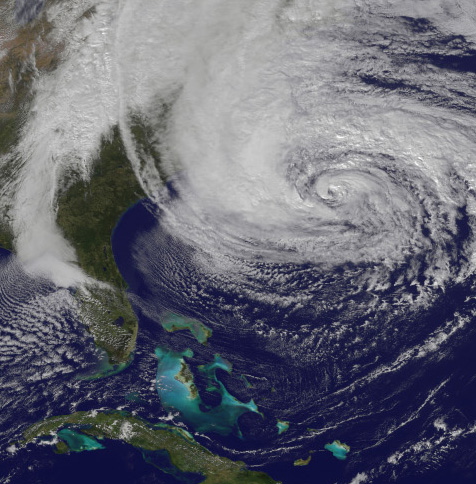Superstorm “Sandy” 2 years later – some observations
 October 29 — Exactly two years ago Superstorm Sandy pounded the shoreline from South New Jersey to Long Island and beyond. The unusual cyclone, a thousand miles in diameter, drove a wall of water as much as fourteen feet above normal at New York City, with effects reaching far up the Hudson.
October 29 — Exactly two years ago Superstorm Sandy pounded the shoreline from South New Jersey to Long Island and beyond. The unusual cyclone, a thousand miles in diameter, drove a wall of water as much as fourteen feet above normal at New York City, with effects reaching far up the Hudson.
That Tuesday morning the world witnessed a scene seemingly out of a disaster movie with blocks of houses scraped clean off their foundations, much of Manhattan without electricity, subways flooded, and cars floating out of tunnels. It can fairly be said that our perception of vulnerability to coastal flooding changed that night.
With eerie timing, my book High Tide On Main Street had just been published a week earlier and described that scenario in that location. That timing coincidence started me on a fast track of interviews, public presentations, and in depth explanations for companies and communities. It was a tragic natural event, that created an opportunity to explain storms, extreme tides, and sea level rise with a new focus and reality.
Now is a good point to look back and recap where things stand today, emanating from that record setting storm.
With the passage of time and the tremendous lure of the coast, the bad memories are starting to fade. Things are returning to normal, but it is a new normal. There are areas with fresh construction, looking better than ever, but in some places, around the corner, Sandy’s tracks are still in clear view.
Many homes, businesses, and towns have been rebuilt to be more resilient in anticipation of the “next Sandy.” But even two years later, much rebuilding is still in process. Parts of the subway system and other infrastructure are not yet even fully functional.
In terms of real estate values, prices have rebounded considerably from the post-storm lows. Some residents have retreated from the vulnerable zone or are quietly waiting for property values to recover sufficiently, to allow them to sell and relocate elsewhere. It may be too early to prove, but there are signs that concerns about flooding from storms, extreme high tides, and rising sea level are creating some ‘downward pressure’ on values.
“Sandy” was an unusual storm event — truly huge, coming from the worst possible direction, and hitting at an unusually high tide, making the effects even worse. In addition, the base sea level in that region is 14 inches (35 cm) higher than a century ago, when the subways and other infrastructure were designed and constructed. That higher sea level raised and therefore increased the effect of the storm surge.
As the sea level rises higher and higher by the decade — and it will — the effects of storms in the future could be even worse. What is challenging to keep in mind is that storms and unstoppable rising sea level may have similar effects of flooding, but they are completely different.
Storms hit a localized region. The worst impact is at the shoreline. The waters quickly recede allowing recovery. The timing, location, and magnitude of storms defy prediction.
Rising sea level hits ALL coastal locations globally. Impacts are not limited by sand dunes or other energy absorbing structures. The effects can reach hundreds of miles inland through rivers, creeks, and marshes. The water will NOT recede for centuries, meaning the land is lost rather permanently.
Sea level will just keep rising as the oceans warm and expand, and as the glaciers and ice sheets on land melt. No credible technology can cool the ocean and get the glaciers and ice sheets back into “growth mode.” The relationship between global temperature over decades, the amount of ice on the planet, and the height of the ocean is dictated by physics and recorded by geology. Rising sea levels will be with us for centuries. It is a new reality. We can slow the warming of our planet and should, which will keep sea level from rising even faster. Regardless of our success at reducing greenhouse gases this century, it is critical that communities, businesses, and individuals begin adapting to rising seas and shifting shorelines.
Looking back at where we are two years after Sandy, we also still have a lot of policy work to consider and change, such as:
- Debates in the US about how much the government should (or can afford) to subsidize flood insurance continues.
- The precedent of helping people to recover at public expense when they have built on a floodplain will get more and more expensive, for the FEMA funds which need to be replenished with greater frequency, from a budget already far out of balance.
- Post-Sandy programs like the one where New York residents in vulnerable neighborhoods can sell their property at pre-storm valuations to the government, may seem like a good way to help us migrate from the vulnerable coast. Yet, the long term cost of such programs needs to be considered as they are not economically sustainable.
Superstorm Sandy was a wakeup call to the power of the deadly combination of storms, extreme tides, and sea level rise. Fully embracing this new reality will not happen overnight. Let’s hope it does not take another major disaster to get communities, business leaders and elected officials started on what I describe as intelligent adaptation to ever-rising sea level, at the same time that we try to design and build for more resiliency for possible storms of the future.
